Tahoe Rim Trail 100 mile July 15-16, 2017
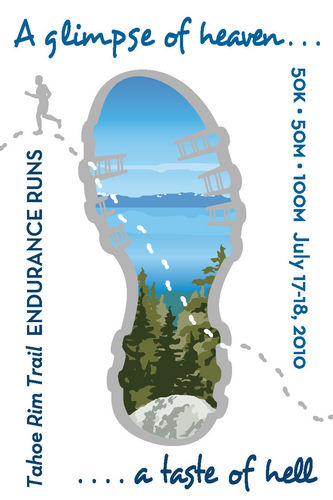
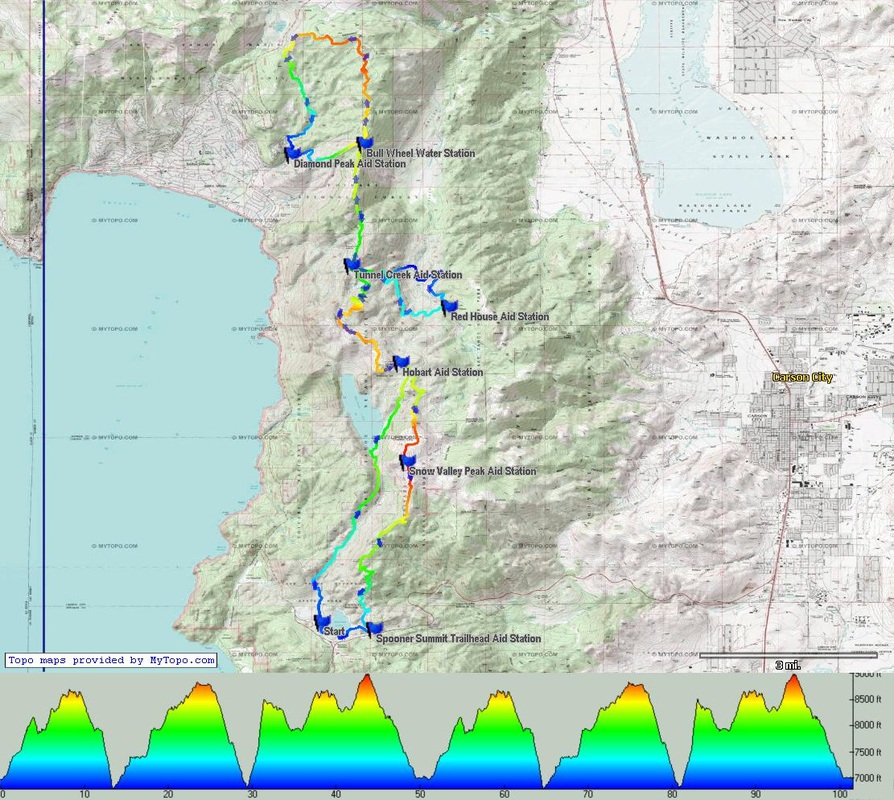
I must have been asked about 20 times, "Why did you sign up for
TRT 100 again?" The answer was complicated. I had a great time last
year and I love the events that the Tahoe area running groups put
on. Yes, we finished the race, but I also felt like I possibly left
something on the table. I also wanted to prove it wasn't a fluke that
I was able to finish a mountain 100 mile race. So, here Kristin and I
are again in 2017 doing it again!
The training plan was similar to the previous year. Instead of
Gorge Waterfall, we would do Canyons 100k. However, we still
planned to do the Silver State 50 and the Western States training
weekend. After fatigue set in, we ended up DNFing Silver State (by
choice) and opting to conserve our energy for the training
weekend. Both Kristin and I had overuse injuries of various states
and wanted to be certain to have fun at States. Overall, our plan
ended up being this:
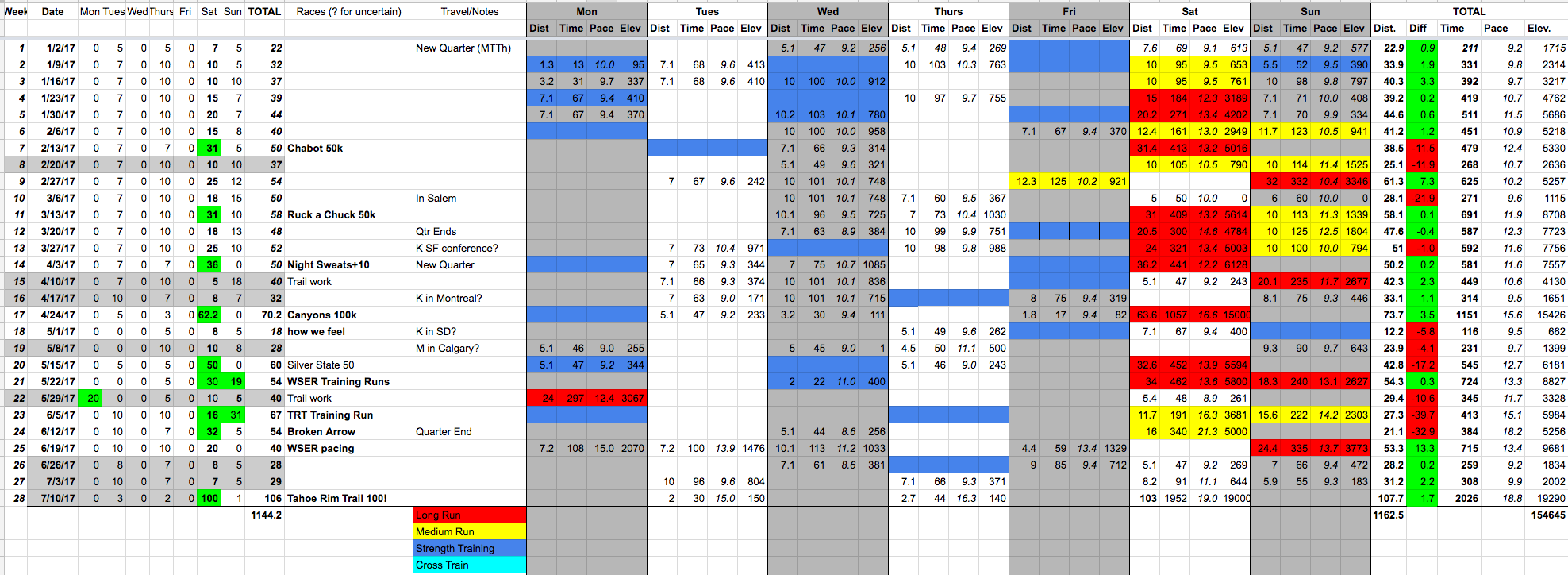
Last year, my achilles was problematic after Silver State, but I
kept doing my physical therapy, stretches, etc. this year. We also did
1-2 days a week of strength training (marked in blue) which included
mostly upper-body but also significant leg workouts when there wasn't
a race the next weekend.
Kristin and I also had a vacation in Tahoe between Broken Arrow Sky
Race and Western States pacing this year. Rather than return home for
a couple days, we stayed at elevation and in the heat of Tahoe. We got
a bunch of good mountain runs in near Squaw and Alpine Meadows. We
made sure to do the runs mid-day so they were hot. There was also
significant snow both in the Sky Race and our training runs. This
ended up being great practice!
The snow practice was good, because TRT ended up having at least a few miles of
snow on the course. However, it also stressed my peroneal tendon due to
the lateral movements in soft snow. This started to get bad after the
Western States training weekend and I took a few weeks off from most
training. It got better, eventually, with some minor rehab. Earlier,
it also took us much longer to recover from Canyons 100k than I had
previously thought. That is a HARD 100k, but it was also great
training for TRT.
I decided to do some heat training in the final weeks since my mileage
was low from the injuries. Although it wasn't expected to be "hot", I
don't deal well with heat. I ended up sitting in a sauna for up to 30
minutes 2x a week with a sweatshirt and winter hat. This helped me
adapt.
Going into the race, my main goal was to not blow up. Last year, I had
a rough time going up Diamond Peak the first time (mile 30). I felt sick and this cost us
about 45 minutes. I had a second rough patch after mile 50 when it got dark. I attribute this
to not eating enough. This cost us probably another hour. By improving these two things,
I hoped that we could not only finish again, but potentially improve the time.
There are always surprises in ultras. This year, they were fairly minor. There was quite a bit of snow on
the course and where there wasn't snow, there was some melted snow (aka water!). We made sure to plan for
plenty of sock changes to prevent blisters. I used the expensive Drymax orange socks and a new pair of
Altra Olympus 2.5s. The Altras seem to have fixed the rubbing problems on my toe that I had with the previous
2.0s. I ended up not having a single blister after 100 miles. Here is an action shot sliding down a snow bank:
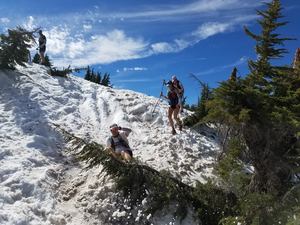
The first bout with Diamond Peak (mile 30) was much better than last
year. I had a minute or two of nausea, but it went away
quickly. Taking a bit of extra time going up it ended up saving a lot
of time getting to the next aid station. Here's a pic of DP from afar
(the lower slopes on the right and the peak on the upper left behind the trees). It's a WTF
climb.
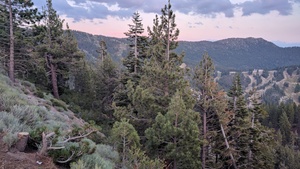
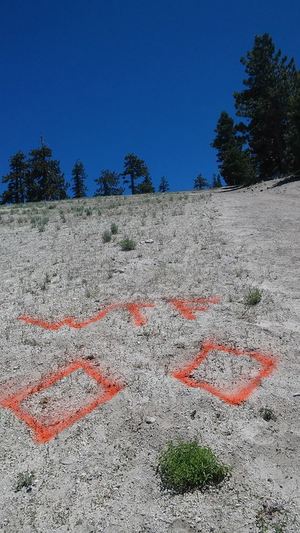
We finished the first loop (mile 50) before dusk which was about 1 hour faster
than last year. We were able to move along into the next loop quite a
ways before it ended up getting dark. I drank a Red Bull at this point
whereas last year I didn't have one until mile 63. This helped.
On the topic of nutrition, since I'm vegetarian and I can't tolerate
dairy, food choices are often problematic. A few things ended up
working this year:
- Orgain Protein Drinks
- Potatoes (TRTER tots at Tunnel Creek and mashed potatoes at Red House)
- Vanilla Oreos
- Beer. Yes, beer. I had a swig at at least 4 aid stations to mix up my palate.
Seems pretty basic, but I also supplemented with Gu chomps, potato
chips, fruit, breakfast, and whatever else sounded good at the time. I
had no GI issues unlike last year, but I did have to use the bathrooms
a few times.
After leaving the 50 mile point, we hiked through much of the night with our pacers Justin and Leah. It
was on fairly hilly and technical (rocks and snow) portions of the
course, so we didn't lose much time, but we did do it a bit slower
than last year. Not a big deal, we planned to run more in the daylight. We got to Diamond Peak lodge
just after dawn which was much earlier than the prior year. This had it's benefits... climbing Diamond Peak in the shade!
Overall, here are the different times of the segments comparing last year and this year:
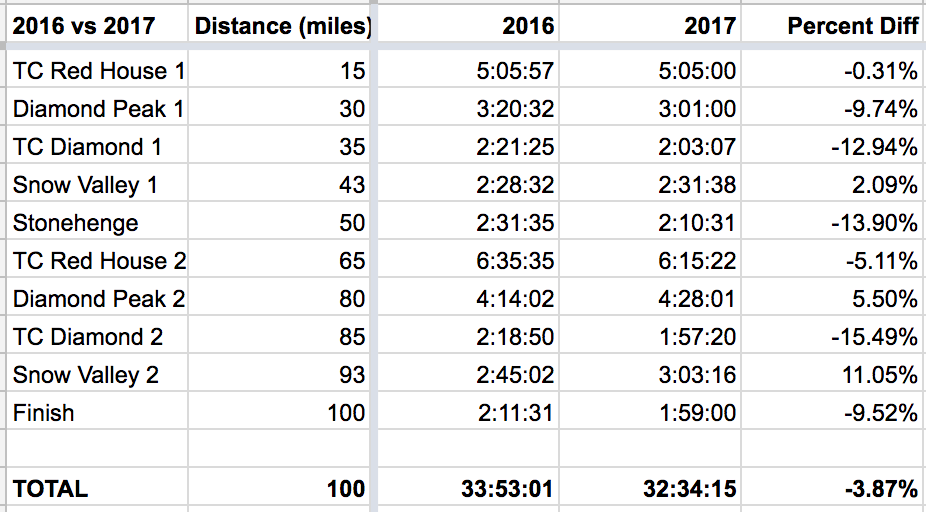
We did several
segments of the first loop 10% faster or, at the least, about the
same. We were slower going up Diamond Peak, but that time was made up
from the top to the next aid station. We closed the first loop from
Snow Valley peak almost 14% faster which resulted in a 50 mile split
an hour faster than last year.
On the second loop, we gained about 20 minutes right at the start
because I had enough calories at the mid-point. Through the night, we
slowed a bit to mile 80, because Kristin and I were both getting
sore. The second climb up Diamond Peak, however, was over 15% faster than last
year and 10 minutes faster than the first time in the race. This is
mostly, because we climbed it before the sun crested which was a HUGE
advantage. It was steep, but not hot! We did take some extra time at
Hobart and the final climb to Snow Valley Peak, but we were able to
close the last 7 miles almost 10% faster than last year.
Overall, we finished about 1 hour 20 minutes faster, but, more importantly, we felt strong!
Kristin and I with our buckles at breakfast the next day:
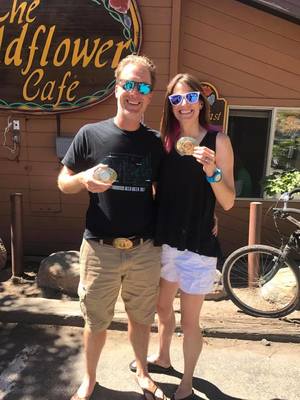
This year's buckle (left) and last year's (right):
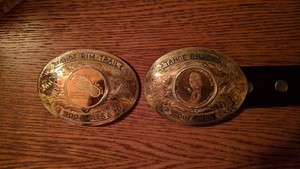
Special thanks to all that helped us along the way. Don, Kathy,
Justin, Leah, the vounteers at all the aid stations, the
TRTER tots at Tunnel Creek, and all the other runners.
What I learned (or remembered again!):
- Heat training is useful even if it won't be "hot"
- Eat, eat, eat. The vegan soy drink I got was perfect and I had no GI issues.
- Ice in my side pocket of my pack is awesome.
- Strength training should be a major component of my training.
- Frequent sock changes (4x) and the Olympus 2.5's resulted in NO BLISTERS.
Strava results
Ultrasignup Results








